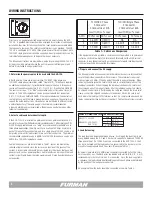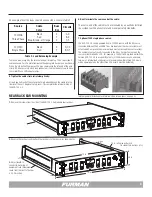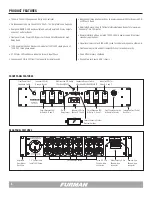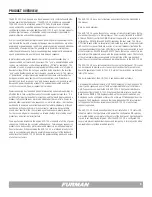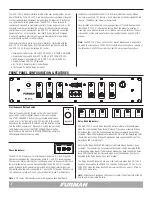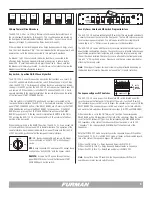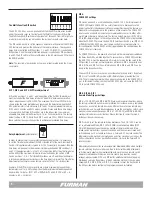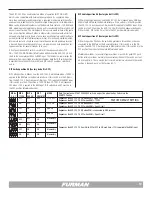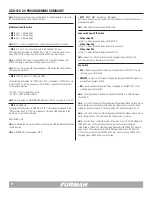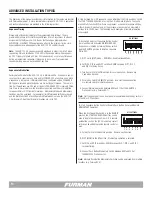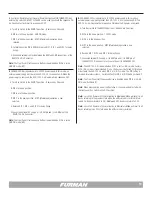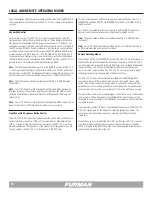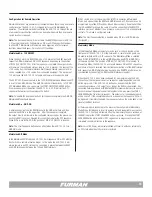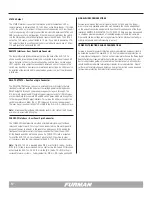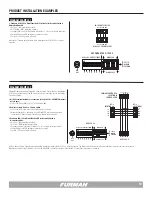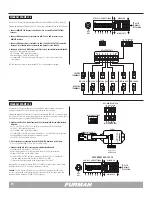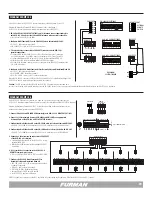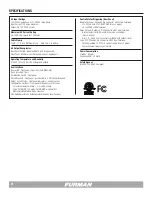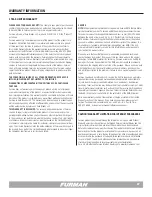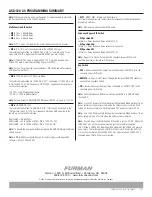
17
STATUS Output
The STATUS terminal is an output that may be used to illuminate an LED at
remote locations to indicate the ASD-120 2.0 has active Delay Banks. If it is high
(+12V), the unit is on (or at least in the process of sequencing on); if low, the unit
is off (or sequencing off). Simply connect the indicator LED between STATUS and
GND (a series resistor is not required). If the LED does not light when the switch
is in the ON position, check the polarity and reverse the LED leads. The STATUS
output is a 12V source, current limited to 10 mA. If you wish to generate a STA-
TUS output voltage to a confidence monitor or an indicator, please use a 1k Ohm
1/4-watt resistor in series with the LED.
REMOTE Interface – Rear Panel 4 pin Connector
The four pin Remote Interface terminal strip on the back of the ASD-120 2.0
allows a switch (or parallel switches) to be connected to turn the unit on and off
from a distance. In the most basic configuration, only two Class 2 wires and an
SPST switch or relay contacts are needed to initiate an on or off sequence. The
switch may be either a momentary or maintained-contact type. An LED may also
be installed at the remote end to indicate when power is on, but this will require
a third wire.
DELAY OUTPUTS – Rear Panel 8 pin Connector
The DELAY OUTPUTS are a series of six isolated dry switch contacts that are
intended to interface with the end user’s low voltage power switching devices.
DELAY outputs A through F correspond to sequence stages A through F. The
N.C. (normally closed) and NO (normally open) relay contacts of all DELAY relays
are combined into two separate NO and NC switch buses which are brought out
to the rear panel DELAY Output interface. This allows the end user to select the
switching preference, either N.C. or NO, to be used for connected equipment.
The user may also connect either 12V or GND to the N.O. or N.C. switch contacts.
Note:
A front panel Delay Bank LED indicator confirms the state of the DC relay
as well as its associated AC duplex.
FORCE OFF Interface – Rear Panel 2 pin Connector
The FORCE OFF input provides a method of immediately turning off all Bank
relays and output circuits. This input can be connected to a fire alarm panel to
disconnect power to all loads in the event of an emergency. DIP 4 behind the
front panel cover plate controls the trigger condition that forces the unit OFF.
All the Delay Bank LEDS will blink in unison if a FORCE OFF state is activated.
To reset the ASD-120 2.0, turn the Key Switch to the OFF position to clear
or if necessary, cede the service power to the ASD-120 2.0 to reset and clear.
Note:
The ASD-120 2.0 is disabled when DIP 4 is set for (N.C.) mode. Factory
DIP 4 (N.O.) mode is recommended. Only a short across the Forced Off terminals
will activate the ASD-120 2.0 if DIP 4 is in the (N.C.) mode. This DIP setting is
reserved for alarm systems. Factory default for DIP 4 is (N.O) mode position UP.
SIGNAL WIRE CONSIDERATIONS
Furman recommends that control signal wires be 24 to 28 awg. this type of
wire is commonly available and works well. Generally, the choice is dependent
on the amount connected equipment to be utilized through any one of the three
interfaces REMOTE, DELAY OUTPUTS or FORCE OFF. Wire nuts may be required
in situations where many pieces of controlled equipment share the same pin.
Please note the low-voltage control signal must establish electrical continuity in
order to be reliable and craftsmanship is a must.
POWER DISTRIBUTION DESIGN CONSIDERATIONS
Furman is known for power distribution and surge protection, however it should
be noted the design of the new ASD-120 2.0 only provides surge protection on
its own internal components. There is neither surge protection on the Delay Bank
Duplex Outlets nor transient protection for the low-level DC contacts. Any con-
ductor can provide a pathway for an electrical transient event, so all conductors
should be addressed when formulating strategies for surge protection. Please
call Furman for information and details on how system installs can be designed
for maximum protection from electrical transient events.

